医学英语研究论文
- 格式:ppt
- 大小:10.79 MB
- 文档页数:180
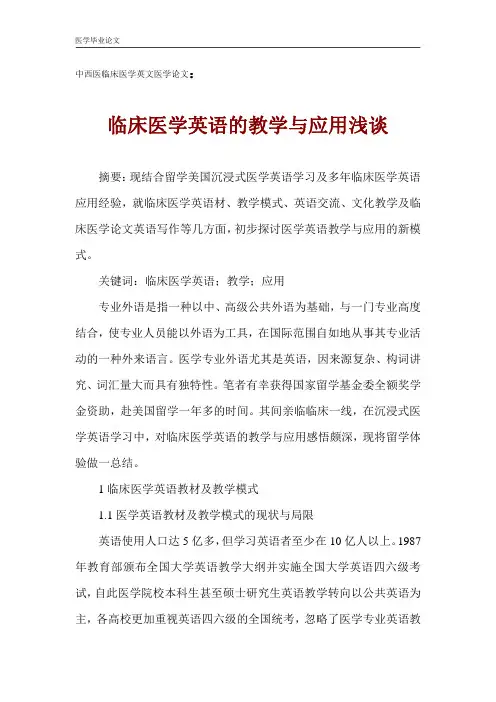
中西医临床医学英文医学论文:临床医学英语的教学与应用浅谈摘要:现结合留学美国沉浸式医学英语学习及多年临床医学英语应用经验,就临床医学英语材、教学模式、英语交流、文化教学及临床医学论文英语写作等几方面,初步探讨医学英语教学与应用的新模式。
关键词:临床医学英语;教学;应用专业外语是指一种以中、高级公共外语为基础,与一门专业高度结合,使专业人员能以外语为工具,在国际范围自如地从事其专业活动的一种外来语言。
医学专业外语尤其是英语,因来源复杂、构词讲究、词汇量大而具有独特性。
笔者有幸获得国家留学基金委全额奖学金资助,赴美国留学一年多的时间。
其间亲临临床一线,在沉浸式医学英语学习中,对临床医学英语的教学与应用感悟颇深,现将留学体验做一总结。
1临床医学英语教材及教学模式1.1医学英语教材及教学模式的现状与局限英语使用人口达5亿多,但学习英语者至少在10亿人以上。
1987年教育部颁布全国大学英语教学大纲并实施全国大学英语四六级考试,自此医学院校本科生甚至硕士研究生英语教学转向以公共英语为主,各高校更加重视英语四六级的全国统考,忽略了医学专业英语教学。
医学专业英语教学多年来一直使用传统英语教材和公共英语的教学方法。
医学英语教材多是科普文章或基础医学的科研型文章,涉及临床实际应用信息的内容很少,内容多零乱片面,系统性及实用性较差。
尤其在研究生教学中,没有与其专业相匹配的教材。
这样的后果是,学生的英语学习与实际应用脱节。
学生的主要精力仅仅停留在应付考试上。
数据显示,学生对传统单一课型教学模式极为不满,超过90%的学生希望结合医学专业,并根据自身特点和需求选择不同课型进行学习[1]。
在笔者参加过的一次国内举办的国际学术大会上,在医学毕业生中,甚至是国内名校的博士研究生中都没有找到可以胜任外籍医生讲座翻译工作的人员,更谈不上和外籍医生进行深入的学术交流和讨论了。
笔者曾经多次参加临床英语查房,发现大多数研究生及本科毕业生对临床医学英语知之甚少,甚至不知道疾病的英语名称。
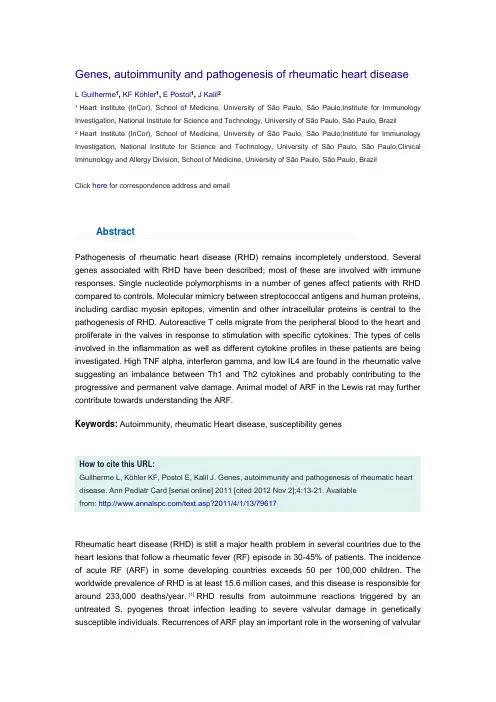
Genes, autoimmunity and pathogenesis of rheumatic heart diseaseL Guilherme1, KF Köhler1, E Postol1, J Kalil21 Heart Institute (InCor), School of Medicine, University of São Paulo, São Paulo;Institute for Immunology Investigation, National Institute for Science and Technology, University of São Paulo, São Paulo, Brazil2 Heart Institute (InCor), School of Medicine, University of São Paulo, São Paulo;Institute for Immunology Investigation, National Institute for Science and Technology, University of São Paulo, São Paulo;Clinical Immunology and Allergy Division, School of Medicine, University of São Paulo, São Paulo, BrazilClick here for correspondence address and emailAbstractPathogenesis of rheumatic heart disease (RHD) remains incompletely understood. Several genes associated with RHD have been described; most of these are involved with immune responses. Single nucleotide polymorphisms in a number of genes affect patients with RHD compared to controls. Molecular mimicry between streptococcal antigens and human proteins, including cardiac myosin epitopes, vimentin and other intracellular proteins is central to the pathogenesis of RHD. Autoreactive T cells migrate from the peripheral blood to the heart and proliferate in the valves in response to stimulation with specific cytokines. The types of cells involved in the inflammation as well as different cytokine profiles in these patients are being investigated. High TNF alpha, interferon gamma, and low IL4 are found in the rheumatic valve suggesting an imbalance between Th1 and Th2 cytokines and probably contributing to the progressive and permanent valve damage. Animal model of ARF in the Lewis rat may further contribute towards understanding the ARF.Keywords: Autoimmunity, rheumatic Heart disease, susceptibility genesHow to cite this URL:Guilherme L, Köhler KF, Postol E, Kalil J. Genes, autoimmunity and pathogenesis of rheumatic heart disease. Ann Pediatr Card [serial online] 2011 [cited 2012 Nov 2];4:13-21. Availablefrom: /text.asp?2011/4/1/13/79617Rheumatic heart disease (RHD) is still a major health problem in several countries due to the heart lesions that follow a rheumatic fever (RF) episode in 30-45% of patients. The incidence of acute RF (ARF) in some developing countries exceeds 50 per 100,000 children. The worldwide prevalence of RHD is at least 15.6 million cases, and this disease is responsible for around 233,000 deaths/year. [1] RHD results from autoimmune reactions triggered by an untreated S. pyogenes throat infection leading to severe valvular damage in genetically susceptible individuals. Recurrences of ARF play an important role in the worsening of valvularlesionss. [2],[3]In the present review, we focus on genetic susceptibility factors, their role in the development of RF and RHD, and the mechanisms that lead to autoimmune reactions and permanent valvular damage. Animal models of the disease will also be discussed, as will prospective vaccines for the prevention of RF and RHD.Innate and Adaptive Immune Responses : A Brief ReviewProtection against pathogens in the humans relies on complex interactions between innate and adaptive immunity. Most of the pathogens that enter the body are recognized initially by the innate immune system. [4]This defense mechanism is not antigen-specific and is instead focused on the recognition of a limited number of specific patterns that are shared by groups of pathogens (pathogen-associated molecular patterns - PAMPs) by pattern recognition receptors (PRRs) in the host. These PRRs can be soluble in human serum or cell-associated. [5],[6]The molecules that initiate the complement cascade are examples of soluble PRRs. The complement system is part of the innate immune system and consists of many proteins involved in a cascade of proteolysis and protein complex assembly that culminates in the elimination of invading pathogens. [6] Several components of the bacterial cell surface combine with PRRs such as Ficolin family of proteins, or Mannan binding lectins (MBL). These complexes, in turn combine with serine proteases and lead to complement activation via lectin pathway resulting in opsonophagocytosis of the invading pathogen, apoptosis, or modulation of inflammation. [7],[8],[9],[10]Toll-like receptors (TLRs) are pivotal cell-associated PRRs in the innate immune system. These receptors are capable of recognizing a wide spectrum of organisms, including viruses, bacteria and other parasites, and are classified into different groups based on their localization (cell surface or intracellular) and the type of PAMPs they recognize. TLR activation leads to the production of proinflammatory cytokines that enable macrophages and dendritic cells (DC) to eliminate invading pathogens. DCs can stimulate T cell expansion and differentiation, initiating an adaptive immune response. [4] The molecules produced during the innate immune response act as signals to activate adaptive immune responses. Antigen presenting cells (APCs), such as DCs, are activated and express costimulatory (CD80 and CD86) and MHC molecules on their cell surface that enable these cells to present processed antigens to T cells through the T cell receptor (TCR). Class I MHC molecules, such as HLA-A, -B and -C, present peptides derived from intracellular pathogens to CD8 + T cells, while class II MHC molecules, such as HLA-DR, -DQ and -DP, present peptides derived from extracellular pathogens to CD4 + T cells, which secrete a wide range of cytokines and have both effector and regulatory roles. Cytokines such as TNF-a and IFN-g act at the site of infection and can affect pathogensurvival and control the immune response. Activation of CD4 + T cells not only leads to the expansion of CD4 + effector cells, but also can promote the expansion and differentiation of antigen-specific CD8 + T cells and B cells. [4]CytokinesCytokines seem to play a pivotal role in the activation of immunological and inflammatory responses in RF. It has been shown that peripheral blood mononuclear cells (PBMC) from children with RF produce more TNF-α than heal thy controls. [20] Moreover, interleukin-6 (IL-6) and TNF-α are considered inducers of the acute phase of RF and are strongly correlated with C-reactive protein. [21],[22]TNF-α is a proinflammatory cytokine that has been associated with the severity of different autoimmune and inflammatory diseases. The gene that encodes this cytokine is located within the MHC region on chromosome 6p21.3. This region is highly polymorphic, and the TNF-alpha gene also contains a large number of polymorphisms. [23] Some of these were investigated in RF/RHD patients in different countries. An SNP in the promoter region of TNF-alpha (-308A) was associated with susceptibility to RHD in Mexico, Turkey, Brazil, and Egypt. [21],[22],[23],[24],[25],[26] The TNF-alpha -238G allele was also associated with RHD in Mexican and Brazilian patients. [24],[25] The TNF-alpha gene has a proinflammatory effect and is probably associated with the exacerbation of the inflammatory response in RF/RHD patients who present with high serum TNF-α levels[20],[22],[27],[28] and large numbers of TNF-α-producing cells in the throat and valves. [29]Polymorphisms in other cytokine genes have also been investigated and seem to be involved with the disease. These include TGF beta1, [30],[31] interleukin-1 receptor antagonist (IL1Ra), [32] interleukin 10, [21] amongst others. In Taiwanese RHD patients, both the -509T and 869T alleles of TGF beta 1 were found to be risk factors for the development of valvular RHD lesions. [30] Similar results were found in Egyptian patients. [31] RHD patients from Egypt and Brazil with severe carditis showed low frequencies of allele 1 for IL1Ra, suggesting the absence of control of the inflammatory process. [21],[32]Interleukin-10 (IL-10) is one of the most important anti-inflammatory cytokines, together with TGF-β and IL-35. It is produced by activated immune cells, especially monocytes/macrophages and T cell subsets, including regulatory T cells (Tr1 and Treg) and Th1 cells. IL-10 acts through a transmembrane receptor complex, and regulates the functions of many different immune cells. [33]The gene encoding human IL-10 is located on chromosome 1. A large number of polymorphisms have been identified in the IL-10 gene promoter. The genotype IL-10 -1082G/A that is overrepresented in RHD Egyptian patients is associated with the development of multiple valvular lesions (MVL) and with the severity of RHD. [21] More recently, polymorphism in cytotoxic T cell Lymphocyte antigen 4 (CTLA-4), which is a negative regulator of T cell proliferation has also been shown in Turkish RHD patients.[34]Human Leucocyte AntigenHuman leucocyte antigen (HLA) molecules are encoded by the HLA genes (-A, -B, -C, -DR, -DQ and -DP), which are located on the short arm of human chromosome 6. Early studies of susceptibility for RF/RHD pointed out the association of the disease with several HLA class II alleles, mainly those encoded by the DR and DQ genes.Several HLA class II alleles were described in locations around the world [Figure 2]. [35],[36]Figure 2: RF/RHD associated HLA class II alleles:distribution around the world Several identifiedalleles by serology in the 80`s and/or molecularbiology after the 90`s were shown. Americas: (USA,Mexico, Martinique, South of Brazil); Asia:(Paquistan-Kashmir, North India, Latvia, Japan,South China), United Arab Emirates: (Saudi Arabia)Europe-Asia: (Turkey), Africa: (South Africa andEgypt)Click here to viewThe HLA-DR7 allele that was found in Brazilian, Turkish, Egyptian, and Latvian patients could be considered the HLA class II gene that is most consistently associated with RF/RHD. HLA-DR4 and -DR7 are associated with HLA-DR53 [Figure 2]. In addition, the association of HLA-DR7 with some HLA-DQB or -DQA alleles may be related to the development of multiple valvular lesions (MVL) in RHD patients in Egypt and in Latvia. [37],[38],[39]The molecular mechanism by which HLA class II molecules confer susceptibility to autoimmune diseases is not clear. As mentioned above, the role of HLA class II molecules is to present antigens to the TCR, leading to the recruitment of large numbers of CD4 + T cells that specifically recognize antigenic peptides from extracellular pathogens and the activation of adaptive immune responses. Therefore, the associated alleles probably encode molecules that facilitate the presentation of some streptococcal peptides to T cells that later trigger autoimmune reactions mediated by molecular mimicry.In summary, several alleles of the HLA class II genes appear to be the dominant contributors to the development of RF and RHD. Polymorphisms (SNPs and variable number of tandem repeat sequences of nucleotides) in genes involved with inflammatory responses and host defenses against pathogens that are associated with disease probably contribute to the development of valvular lesions and can determine the type of rheumatic valvular lesions(stenosis, regurgitation, or both) that occur in RHD patients.Rheumatic Fever and Rheumatic Heart Disease areMediated by Molecular Mimicry Between S.Pyogenes andHuman ProteinsMolecular mimicry between components of B hemolyticus streptococci and human heart tissues is the central problem in the pathogenesis of ARF and RHD. The precise mechanisms are being investigated for many years, and some real progress in the understanding of the pathogenesis is occurring slowly. [40],[41],[42],[43]Both T and B lymphocytes can recognize pathogenic and self antigens via four different types of molecular mimicry: (1) identical amino acid sequences, (2) homologous but non-identical sequences, (3) common or similar amino acid sequences of different molecules (proteins, carbohydrates) and (4) structural similarities between the microbe or environmental agent and its host.[43],[44] Autoimmune diseases from molecular mimicry may be facilitated because of the phenomena of epitope spreading and TCR degeneracy. Epitope spreading is the mechanism by which an ongoing immune response leads to reactivity against epitopes that are distinct from the original disease-inducing epitope [43],[45] and degeneracy of TCRs, which allows the recognition of a broad spectrum of antigens (self and microbial antigens) by the same T lymphocyte through it`s receptor. [41],[42],[46]The M protein is the most important antigenic structure of the S. pyogenes and shares structural homology with a-helical coiled-coil human proteins such as cardiac myosin, tropomyosin, keratin, laminin, vimentin and several valvular proteins. [40],[41],[42],[47]Several studies done in the last 50 years described the presence of cross-reactivity between human proteins and streptococcal antigens recognized by antibodies. [40] Among these human proteins, cardiac myosin and vimentin seem to be the major targets of cross-reactive reactions, along with other intracellular valvular proteins. N-acetyl ß-D-glucosamine, a polysaccharide present in streptococcal cell wall, induces cross-reactivity against laminin, an extracellular matrix alpha helical coiled-coil protein present in the valves. [40] By using affinity purified anti-myosin antibodies, Cunningham΄s group identified a five amino acid (Gln-Lys-Ser-Lys-Gln) epitope of the N-terminal M proteins of serotypes 5 and 6 (M5, M6) as being cross-reactive with cardiac myosin. [40]The interplay of humoral and cellular immune responses in RHD was recently demonstrated by Cunningham΄s group through two elegant studies. They showed that, in rheumatic carditis, antibodies that cross-react with streptococcal and human proteins bind to the endothelial surface and upregulate the adhesion molecule VCAM-1 [48] , leading to inflammation, cellular infiltration and valve scarring. [49] These data suggest that ARF may result from initial antibody mediated damage that later may be perpetuated by cell mediated inflammation. [50]Although antibodies in the sera of RF/RHD patients cross-react with several human proteins, we demonstrated that rheumatic heart disease lesions are mediated mainly by inflammatory cells and CD4 + T lymphocytes. [51]Studies performed in the last 25 years showed that CD4 + T cells are the major effectors of autoimmune reactions in the heart tissue in RHD patients. [51],[52],[53] The in vitro reactivity of peripheral T cells from RHD patients was evaluated in an early study that showed that these cells were able to recognize a 50- to 54-kDa myocardial protein fraction indicating autoreactivity to heart antigens, which was probably caused by streptococcal infection. [54] The role of T cells in the pathogenesis of RF and RHD was demonstrated through the analysis of heart-tissue infiltrating T cell clones. We demonstrated for the first time that M5 protein peptides (residues 81-96 and 83-103) displayed cross-reactivity with valvular proteins by molecular mimicry. [51] We also showed that valve-infiltrating T cells recognized cardiac myosin peptides by molecular mimicry and epitope spreading mechanisms. [55]These immunodominant M5 epitopes were preferentially recognized by peripheral T lymphocytes from RHD patients, when compared with normal individuals, mainly in the context of HLA-DR7. [56] These results suggested that autoreactive T cells migrate from the periphery to the site of heart lesions. Similarly, Yoshinaga et al. [57] reported that T cell lines derived from heart valve specimens and PBMC from RF and RHD patients react with cell wall and membrane streptococcal antigens. These lymphocytes, however, did not cross-react with the M protein or mammalian cytoskeletal proteins. [57]Recently, two studies demonstrated mimicry between cardiac myosin and the streptococcal M protein and pointed out different patterns of T cell antigen cross-recognition. One of them focused on peripheral T cell clones from one patient with RHD, which recognized different alpha helical coiled-coil proteins, such as the streptococcal M protein, myosin, laminin and tropomyosin. [58]The other study focused on the reactivity of intralesional T cell clones derived from myocardium and valvular tissue of six RHD patients against cardiac myosin, the streptococcal M5 protein and valve-derived proteins. A high frequency of reactive T cell clones was found (63%). These T cells displayed three patterns of cross-reactivity: (1) cardiac myosin and valve-derived proteins; (2) cardiac myosin and streptococcal M5 peptides; and (3) cardiac myosin, streptococcal M5 peptides and valve-derived proteins.[55]Using a proteomics approach, we showed that T cells recognize vimentin, further supporting the role of this protein as a putative autoantigen involved in rheumatic lesions. In addition, we identified myocardial and valvular autoantigens that were recognized by heart-infiltrating and peripheral T cells from RF/RHD patients. Novel heart tissue proteins were identified, including disulfide isomerase ER-60 precursor (PDIA3) protein and a 78-kDa glucose-regulated protein precursor (HSPA5). [59] However, their role in RHD pathogenesis and other autoimmune diseases is not clear.As mentioned above, both epitope spreading and the degeneracy of T cell receptors contributed to the amplification of cross-reactivity that leads to tissue damage.By using a molecular approach, we evaluated Vb chain usage by TCRs and the degree of clonality of heart-tissue infiltrating T cells. In RHD, the autoreactive T lymphocytes that infiltrate both the myocardium and the valves were identified in oligoclonal expansions by analyzing their TCRs. A high number of T cell oligoclonal expansions were found in the valvular tissue, indicating that specific and cross-reactive T cells migrate to the valves. [49]An effective immune response depends on cytokine production. CD4 + T helper cells are crucial regulators of the adaptive immune response. Antigen-activated CD4 + T cells become polarized toward a Th1 or Th2 phenotype based on the cytokines they secrete. Th1 cells are involved with cellular immune response and produce IL-2, IFN-γ and TNF-α. Th2 cells mediate humoral and allergic immune responses and produce IL-4, IL-5 and IL-13. A new lineage of CD4 + T cells (Th17) was recently described and is characterized by the production of IL-17. In vitro studies indicated a proinflammatory function for IL-17, and its expression was found to be associated with some inflammatory and autoimmune diseases. [60],[61]The role of cytokines in RF/RHD was first evaluated by examining the sera of patients and peripheral mononuclear cells stimulated by streptococcal antigens. These samples showed increased amounts of proinflammatory cytokines (IL-1, IL-6, TNF-a and IFN-g). [62] Immunohistochemistry on heart tissue (myocardium and valves) from acute and chronic RHD patients, showed a large number of mononuclear cells able to secrete TNF-a, IFN-g and the regulatory cytokine IL-10. Importantly, while a significant number of IL-4 + cells were found in the myocardium, these cells were very scarce in valve lesions in RHD patients. It is important to remember that valve damage and not myocarditis is the main problem in ARF. These observations indicated a role for balanced Th1/Th2 cytokines in healing myocarditis and in the induction of progressive and permanent valve damage. [29] IL-17 and Il-23 (Th17 cytokines) were recently analyzed by immunohistochemistry in both myocardium and valvular tissue from RHD patients. We observed a large number of IL-17 + and IL-23 + heart-tissue infiltrating cells (unpublished results), showing that these cytokines also play an important role in the development of heart lesions.Animal Models of RF/RHDHumans are unique hosts for S. pyogenes infections.Several studies (in mice, rats, hamsters, rabbits and primates) have been done to find a suitable animal model in which to examine the autoimmune process leading to RF/RHD with little success. [63] In the last decade, a model in Lewis rats has been developed that appears to be useful for the study of RF/RHD. These rats have already been used to induce experimental autoimmune myocarditis and study the pathogenesis of RF/RHD. [64],[65],[66]Immunization of Lewis rats with recombinant M6 protein induced focal myocarditis, myocyte necrosis and valvular heart lesions in three out of six animals. The disease in these animalsincluded verruca-like nodules and the presence of Anitschkow cells, which are large macrophages (also known as caterpillar cells), in mitral valves. Lymph node cells from these animals showed a proliferative response against cardiac myosin, but not skeletal myosin or actin. A CD4 + T cell line responsive to both the M protein and cardiac myosin was also obtained. Taken together, these results confirm the cross-reactivity between the M protein and cardiac myosin triggered by molecular mimicry, as observed in humans, possibly causing a break in tolerance leading to autoimmunity. [67],[68]Similarly, immunizing the Lewis rats with synthetic peptides from the conserved regions of M5 protein, or from B and C regions , or a recombinant M5 proteins have yielded focal myocarditis, infiltration with CD4+T cells, CD68 + macrophage but no typical aschoff`s nodule. [69],[70],[71],[72]Thus the Lewis Rat model could be considered a model of autoimmune valvulitis akin to ARF.Prospective Vaccines against S.PyogenesMany studies have focused on developing a vaccine against S. pyogenes in order to prevent infection and its complications. There are four anti-group A streptococci (GAS) vaccine candidates based on the M protein and eight more candidates based on other streptococci antigens, including group A CHO, C5a peptidase (SCPA), cysteine protease (Spe B), binding proteins similar to fibronectin, opacity factor, lipoproteins, Spes (super antigens) and streptococcal pili. [73]A multivalent vaccine, currently under phase II clinical trials, combines the amino acid sequences of the N-terminal portion of the M protein from the 26 most common strains of GAS in the US as a recombinant protein. [74],[75],[76]Because the C-terminal portion of the M protein is conserved among the 200 strains identified by their emm-types, vaccines based on this region are expected to provide broad coverage. The first attempt to develop a vaccine based on the C-terminal portion of the M protein was performed by Fischetti et al. [77] This vaccine was able to induce protection against S. pyogenes containing homologous (M6) and heterologous (M14) M protein, demonstrating that the use of conserved region-derived peptides could induce protection against different serotypes. [78]Conserved epitopes from the M protein have been also studied by a group from Australia, where the incidence of streptococcal infections in aboriginal communities is very high. Two synthetic peptides from the M5 protein (J8 and J14) were selected, and several formulations presented promising results. [79],[80],[81],[82] A combination of J8 and the fibronectin-binding repeats region (FNBR) of fibronectin I (SfbI) provided enhanced protection against S. pyogenes in mice. [83]We developed a vaccine epitope (StreptInCor) composed of 55 amino acid residues of the C-terminal portion of the M protein that encompasses both T and B cell protective epitopes. [84]The structural, chemical and biological properties of this peptide were evaluated and have shown that StreptInCor is a very stable molecule, an important property for a vaccine candidate. [85] Furthermore, experiments with mice showed that this construct is immunogenic and safe. [86]The greatest challenge for the development of a GAS vaccine resides in the promotion of immunity without generating cross-reactivity with human tissue. An effective and safe vaccine is still needed, most of all in developing countries.ConclusionSeveral genes involved in the control of infection and the immune response play a role in the development of RF and RHD. Some genes are associated with the innate immune response, and others with the adaptive immune response. Many of these genes are responsible for the inflammatory process and autoimmune reactions.In rheumatic carditis, antibodies that cross-react with streptococcal and human proteins upregulate adhesion molecules, leading to inflammation and increased cellular infiltration. CD4 + T cells that cross-react with heart tissue and streptococcal antigens are the major effectors of heart lesions.Large numbers of mononuclear cells that infiltrate rheumatic heart lesions produce inflammatory cytokines (TNF-a and IFN-g) and the imbalance between these cells and the IL-4-producing Th2 cells in the valve tissue might contribute to the progression and maintenance of rheumatic valvular lesions. Th17 cells also play a role in the development of autoimmunity.Several pathogenic M protein epitopes were identified that can induce cross-reactive responses against human proteins. Both epitope spreading and TCR degeneracy increase the possibility of cross-reactivity between infectious agents and self antigens.An animal model of Lewis rat displays similar heart lesions to RHD and is considered a good model of the disease.The development of a vaccine against S. pyogenes is an important goal and, given the number of ongoing studies, will probably be a reality in the near future.。
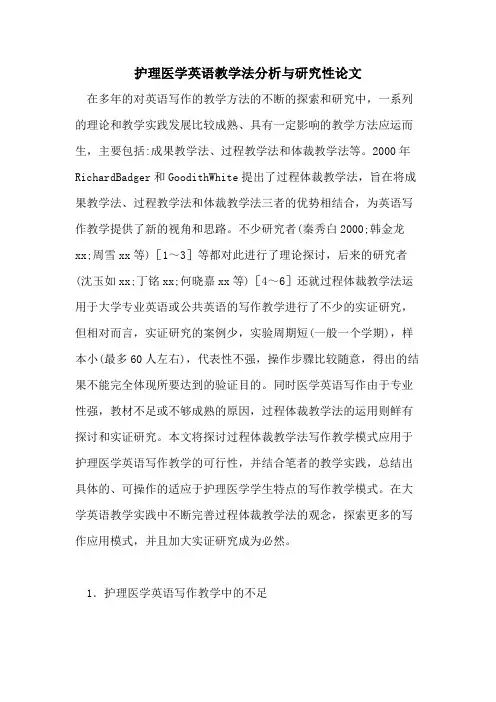
护理医学英语教学法分析与研究性论文在多年的对英语写作的教学方法的不断的探索和研究中,一系列的理论和教学实践发展比较成熟、具有一定影响的教学方法应运而生,主要包括:成果教学法、过程教学法和体裁教学法等。
2000年RichardBadger和GoodithWhite提出了过程体裁教学法,旨在将成果教学法、过程教学法和体裁教学法三者的优势相结合,为英语写作教学提供了新的视角和思路。
不少研究者(秦秀白2000;韩金龙xx;周雪xx等)[1~3]等都对此进行了理论探讨,后来的研究者(沈玉如xx;丁铭xx;何晓嘉xx等)[4~6]还就过程体裁教学法运用于大学专业英语或公共英语的写作教学进行了不少的实证研究,但相对而言,实证研究的案例少,实验周期短(一般一个学期),样本小(最多60人左右),代表性不强,操作步骤比较随意,得出的结果不能完全体现所要达到的验证目的。
同时医学英语写作由于专业性强,教材不足或不够成熟的原因,过程体裁教学法的运用则鲜有探讨和实证研究。
本文将探讨过程体裁教学法写作教学模式应用于护理医学英语写作教学的可行性,并结合笔者的教学实践,总结出具体的、可操作的适应于护理医学学生特点的写作教学模式。
在大学英语教学实践中不断完善过程体裁教学法的观念,探索更多的写作应用模式,并且加大实证研究成为必然。
1.护理医学英语写作教学中的不足护理医学英语写作专业性很强,同时受传统的成果教学法的影响,日常临床护理英语语篇写作教学在护理医学英语写作中一直被有意或无意地回避和忽视。
结果表现为学生不能熟练理解和创作符合日常护理工作的特定体裁的英语语篇文书,对护理工作的日常交往需求准备不足。
从课堂表现来看,学生缺乏良好的写作习惯,语言表达能力差,内容空洞,缺乏创造性的思维模式,写作兴趣索然。
2.过程教学法和体裁教学法在护理医学英语写作教学中的不足(1)过程教学法过程教学法始于20世纪60年代,深受认知理论和交际教学法的影响,是由Graves(1978)提出的。
![对我院医学专业大学生专门用途英语教学[论文]](https://uimg.taocdn.com/c60c9cd06f1aff00bed51e2f.webp)
对我院医学专业大学生专门用途英语教学的探究选择医学专业的本科学生在完成大学英语学习基础阶段后,面临着更高级的外语学习及专业外语学习。
通过对加强专门用途英语教学的必要性和可行性的再认识,明确基础英语教学和专门用途英语教学的实质,提出加强我院专门用途英语教学的建议和措施。
大学英语专门用途英语医学英语一、我国大学英语教学现状我国的高等医学院校的学生在大学英语基础阶段的学习和其他专业一样,使用全国统一的教学大纲,统一教材,统一进度,统一评估标准。
即大学一、二年级的主要目标是打下坚实的语言基础,培养语言交际的基本能力。
争取在全国统一的大学英语四、六级考试中取得好成绩是绝大多数学生孜孜以求的目标,在这一点上,医学生也不例外。
但是,修订后的《大学英语教学大纲》于1999年问世,新大纲对大学英语的教学提出了比以往更高的要求,而且新大纲正式提出了“专业英语”的名称。
“专业英语”的概念产生于第二次世界大战后的上个世纪60年代初期,当时许多国家正面临着严峻的挑战。
他们需要摆脱战争所带来的困境,重振经济、发展科技、加强国际间的交流。
而英语在当时已被认为是科技和商贸领域里的国际语言。
人们学习英语的主要目的是把英语作为一种工具,为自己所从事的专业服务,创造美好的职业生涯。
在这种背景下,语言学家们开始注重专门英语(english for special purpose)的教学。
对于大学基础英语教学,新《大纲》规定:“基础阶段词汇量基本要求和较高要求分别为4200和5500”。
应该说,完成了基础英语学习的学生的语言知识和技能已经达到了相当的程度,完全可以开展esp教学。
另外,不同专业的学生对英语学习的要求侧重于不同方面,从学生专业发展的角度来看,他们也需要提高与自己本专业密切相关的专业英语水平,这就产生了对专业英语学习的需求。
但是,究竟该如何规划、实施esp教学,需要教育管理者和教学实践者自己来进行。
因为医学专业知识的博大精深,自成体系,使得医学专业的大学生很有必要在具备一般英语知识的基础上,学习浩如烟海的医学英语知识,所以要跟上形势的发展,适应学生的需要,满足社会的需求,必须对教学计划和教学材料进行经常性的检查和评估,随时调整我们的教学内容和手段,真正做到以学生为中心。
![[医学英语文章带翻译]医学类英语文章](https://uimg.taocdn.com/a27f7987caaedd3382c4d3da.webp)
[医学英语文章带翻译]医学类英语文章医学英语文章带翻译医学英语文章带翻译医学英语文章带翻译 1 椎间盘突出Unit 2 Text A Herniated Disc (Disc Herniation of the Spine) 第二单元主题 A 椎间盘突出症Many patients with back pain, leg pain, or weakness of the lower extremity muscles arediagnosed with a herniated disc. 许多患腰腿疼痛,下肢肌端乏力的病患均为椎间盘突出症。
When a disc herniation occurs, the cushion that sits between the spinal vertebra is pushedoutside its normal position. 椎间盘突出发生时,脊柱间的缓冲带将发生侧突。
A hrniated disc would not be a problem if it weren“t for the spinal nerves that are very close tothe edge of these spinal discs. 如果脊神经不是离椎间盘特别近的话,椎间盘突出就不是什么大问题了。
HOW ARE THE SPINE AND ITS DISCS *****D 脊柱与椎间盘The vertebras are the bony building blocks of the spine. 脊椎是建造脊柱的构件。
Between each of the largest parts (bodies) of the vertebrae are the discs. 各椎骨之间为椎间盘。
Ligaments are situated around the spine and discs. 脊椎和椎间盘周围散布着韧带。
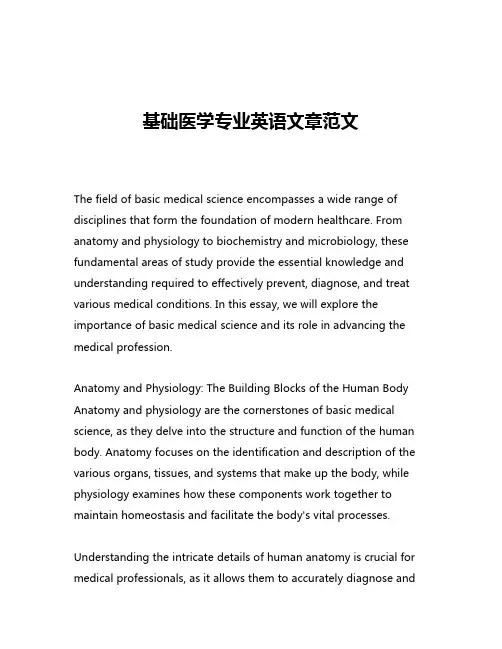
基础医学专业英语文章范文The field of basic medical science encompasses a wide range of disciplines that form the foundation of modern healthcare. From anatomy and physiology to biochemistry and microbiology, these fundamental areas of study provide the essential knowledge and understanding required to effectively prevent, diagnose, and treat various medical conditions. In this essay, we will explore the importance of basic medical science and its role in advancing the medical profession.Anatomy and Physiology: The Building Blocks of the Human Body Anatomy and physiology are the cornerstones of basic medical science, as they delve into the structure and function of the human body. Anatomy focuses on the identification and description of the various organs, tissues, and systems that make up the body, while physiology examines how these components work together to maintain homeostasis and facilitate the body's vital processes.Understanding the intricate details of human anatomy is crucial for medical professionals, as it allows them to accurately diagnose andtreat a wide range of medical conditions. From identifying the location of a fracture to understanding the complex neurological pathways, a comprehensive knowledge of anatomy is essential for effective patient care. Furthermore, the study of physiology provides insights into the body's regulatory mechanisms, enabling healthcare providers to develop targeted interventions and therapies.Biochemistry: The Chemical Basis of LifeBiochemistry is another fundamental discipline within basic medical science, as it explores the chemical processes that underlie the functioning of living organisms. This field of study examines the structure and behavior of biomolecules, such as proteins, lipids, carbohydrates, and nucleic acids, and how they interact to sustain life.Understanding the biochemical mechanisms that govern the body's cellular processes is crucial for developing new diagnostic tools and therapeutic strategies. For example, the study of enzyme kinetics and drug-target interactions can lead to the development of more effective medications, while the analysis of genetic and metabolic pathways can help identify biomarkers for early disease detection.Microbiology: The Invisible Realm of Infectious Agents Microbiology, the study of microscopic organisms, is a crucial component of basic medical science. This field encompasses the investigation of bacteria, viruses, fungi, and other microbes, and theirrole in human health and disease.The knowledge gained from microbiology research is essential for the prevention, diagnosis, and treatment of infectious diseases. By understanding the characteristics, transmission, and pathogenesis of various microorganisms, healthcare professionals can develop effective infection control measures, design targeted antimicrobial therapies, and implement appropriate public health strategies.Furthermore, the study of the human microbiome, the complex community of microbes that reside within the human body, has emerged as a rapidly growing area of research in basic medical science. Insights into the role of the microbiome in maintaining health and its potential involvement in the development of various diseases have opened up new avenues for therapeutic interventions and personalized medicine.Immunology: The Body's Defense SystemImmunology, the study of the immune system, is another crucial component of basic medical science. This field examines the complex mechanisms by which the body recognizes and responds to foreign substances, such as pathogens and allergens, to maintain homeostasis and prevent disease.Understanding the intricate workings of the immune system isessential for the development of effective vaccines, immunotherapies, and treatments for autoimmune disorders. By elucidating the cellular and molecular pathways involved in immune responses, researchers in basic medical science can contribute to the advancement of medical interventions that harness the body's natural defenses to combat a wide range of health challenges.Pathology: Unraveling the Mysteries of DiseasePathology, the study of the underlying causes and effects of diseases, is a fundamental discipline within basic medical science. This field encompasses the investigation of the structural and functional changes that occur in cells, tissues, and organs during the course of a disease, as well as the identification of the factors that contribute to the development and progression of various medical conditions.The knowledge gained from pathological research is crucial for accurate diagnosis, effective treatment, and the development of preventive strategies. By understanding the pathogenesis of diseases, healthcare professionals can design more targeted and personalized interventions, leading to improved patient outcomes.Translational Research: Bridging the Gap between Basic Science and Clinical PracticeThe ultimate goal of basic medical science is to translate the knowledge and insights gained from fundamental research intopractical applications that can benefit patient care. This process, known as translational research, involves the collaborative efforts of basic scientists, clinicians, and other healthcare professionals to ensure that the advancements in basic science are effectively integrated into clinical practice.Through translational research, new discoveries in areas such as genetics, molecular biology, and pharmacology can be transformed into novel diagnostic tools, therapeutic interventions, and preventive strategies. This bidirectional flow of information between the laboratory and the clinic is essential for advancing the medical field and improving the overall health and well-being of patients.ConclusionIn conclusion, basic medical science is the foundation upon which the medical profession rests. By exploring the fundamental aspects of human biology, biochemistry, and microbiology, researchers and healthcare professionals can gain a deeper understanding of the mechanisms underlying health and disease. This knowledge is essential for the development of effective diagnostic tools, therapeutic interventions, and preventive strategies, ultimately leading to improved patient outcomes and the advancement of the medical field as a whole.。
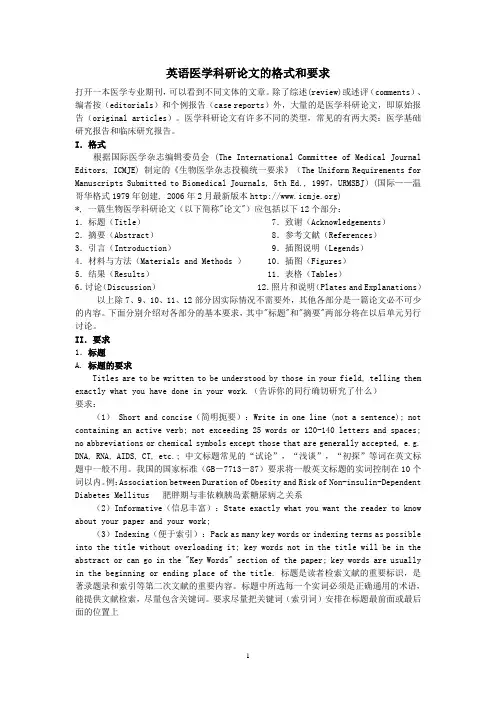
英语医学科研论文的格式和要求打开一本医学专业期刊,可以看到不同文体的文章。
除了综述(review)或述评(comments)、编者按(editorials)和个例报告(case reports)外,大量的是医学科研论文,即原始报告(original articles)。
医学科研论文有许多不同的类型,常见的有两大类:医学基础研究报告和临床研究报告。
I.格式根据国际医学杂志编辑委员会 (The International Committee of Medical Journal Editors, ICMJE) 制定的《生物医学杂志投稿统一要求》(The Uniform Requirements for Manuscripts Submitted to Biomedical Journals, 5th Ed., 1997,URMSBJ)(国际——温哥华格式1979年创建, 2006年2月最新版本)*, 一篇生物医学科研论文(以下简称"论文")应包括以下12个部分:1.标题(Title) 7.致谢(Acknowledgements)2.摘要(Abstract)8.参考文献(References)3.引言(Introduction)9.插图说明(Legends)4.材料与方法(Materials and Methods ) 10.插图(Figures)5.结果(Results)11.表格(Tables)6.讨论(Discussion) 12.照片和说明(Plates and Explanations)以上除7、9、10、11、12部分因实际情况不需要外,其他各部分是一篇论文必不可少的内容。
下面分别介绍对各部分的基本要求,其中"标题"和"摘要"两部分将在以后单元另行讨论。
II.要求1.标题A. 标题的要求Titles are to be written to be understood by those in your field, telling them exactly what you have done in your work.(告诉你的同行确切研究了什么)要求:(1) Short and concise(简明扼要):Write in one line (not a sentence); not containing an active verb; not exceeding 25 words or 120-140 letters and spaces; no abbreviations or chemical symbols except those that are generally accepted, e.g. DNA, RNA, AIDS, CT, etc.; 中文标题常见的“试论”,“浅谈”,“初探”等词在英文标题中一般不用。
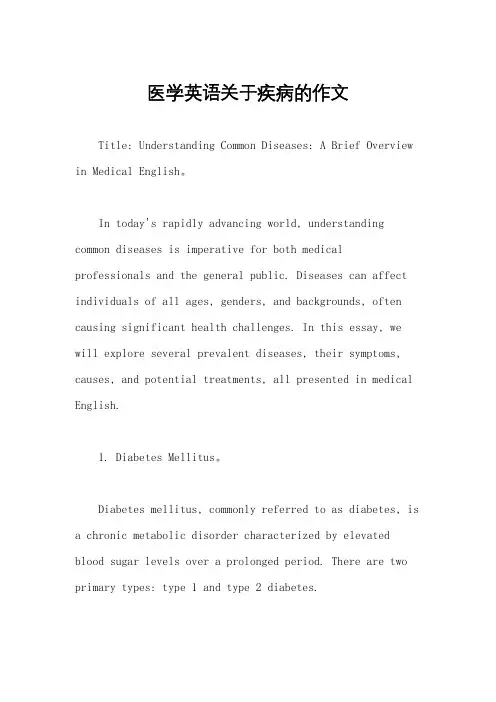
医学英语关于疾病的作文Title: Understanding Common Diseases: A Brief Overview in Medical English。
In today's rapidly advancing world, understanding common diseases is imperative for both medical professionals and the general public. Diseases can affect individuals of all ages, genders, and backgrounds, often causing significant health challenges. In this essay, we will explore several prevalent diseases, their symptoms, causes, and potential treatments, all presented in medical English.1. Diabetes Mellitus。
Diabetes mellitus, commonly referred to as diabetes, is a chronic metabolic disorder characterized by elevated blood sugar levels over a prolonged period. There are two primary types: type 1 and type 2 diabetes.Symptoms: Increased thirst, frequent urination, unexplained weight loss, fatigue, blurred vision, and slow wound healing.Causes: Type 1 diabetes results from the immune system mistakenly attacking insulin-producing beta cells in the pancreas, while type 2 diabetes develops due to insulin resistance and insufficient insulin production.Treatment: Management involves lifestyle modifications such as dietary changes, regular exercise, oral medications, insulin therapy, or a combination thereof.2. Hypertension (High Blood Pressure)。
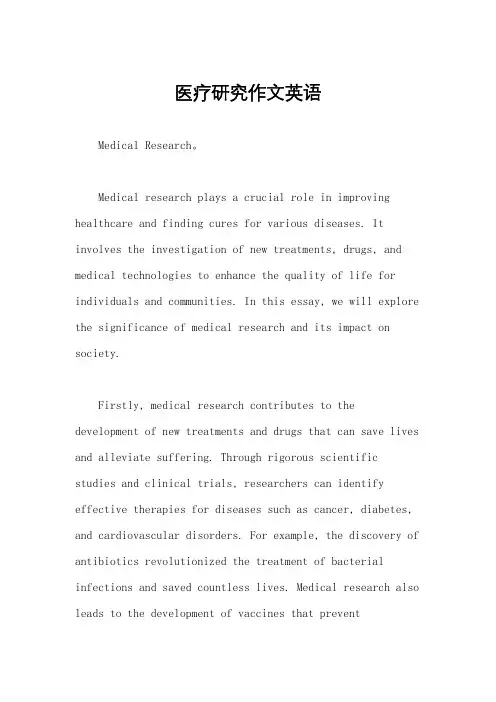
医疗研究作文英语Medical Research。
Medical research plays a crucial role in improving healthcare and finding cures for various diseases. It involves the investigation of new treatments, drugs, and medical technologies to enhance the quality of life for individuals and communities. In this essay, we will explore the significance of medical research and its impact on society.Firstly, medical research contributes to the development of new treatments and drugs that can save lives and alleviate suffering. Through rigorous scientific studies and clinical trials, researchers can identify effective therapies for diseases such as cancer, diabetes, and cardiovascular disorders. For example, the discovery of antibiotics revolutionized the treatment of bacterial infections and saved countless lives. Medical research also leads to the development of vaccines that preventinfectious diseases, such as polio, measles, and influenza. These advancements have had a profound impact on public health and have contributed to the eradication of deadly diseases.Furthermore, medical research plays a critical role in understanding the underlying causes of diseases and identifying risk factors that can inform preventive measures. By studying the genetic, environmental, and lifestyle factors that contribute to disease development, researchers can develop strategies to reduce the burden of illness in populations. For instance, studies on the link between smoking and lung cancer have led to public health campaigns that promote smoking cessation and tobaccocontrol policies. Medical research has also shed light on the importance of healthy eating and physical activity in preventing chronic diseases such as obesity, diabetes, and heart disease.In addition, medical research drives innovation in healthcare by fostering the development of new medical technologies and diagnostic tools. Advanced imagingtechniques, such as MRI and CT scans, enable healthcare providers to visualize internal organs and detect abnormalities with greater precision. Moreover, the use of artificial intelligence and big data analytics has the potential to revolutionize the diagnosis and treatment of diseases by identifying patterns and trends in large datasets. These technological advancements have thepotential to improve patient outcomes and streamline healthcare delivery.Medical research also has a significant economic impact, as it contributes to the growth of the pharmaceutical and biotechnology industries. The development of new drugs and medical devices not only creates jobs and stimulates economic growth but also generates revenue for healthcare providers and pharmaceutical companies. Moreover, medical research attracts investment in healthcare infrastructure and fosters collaboration between academia, industry, and government agencies. This collaboration is essential for translating research findings into clinical practice and ensuring that patients benefit from the latest advancements in medical science.In conclusion, medical research is a cornerstone of modern healthcare and has far-reaching implications for individuals, communities, and societies. By advancing our understanding of disease mechanisms, developing new treatments, and driving innovation in healthcare, medical research has the potential to improve the quality of life for millions of people around the world. Therefore, it is essential to support and invest in medical research to address the healthcare challenges of the 21st century.。
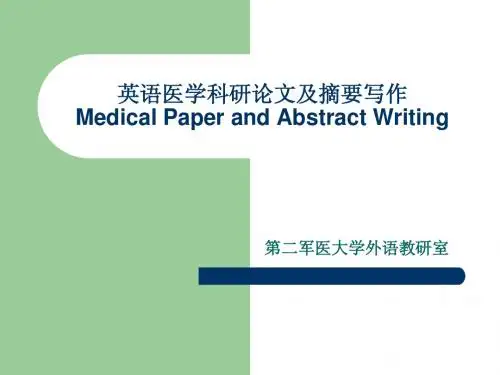
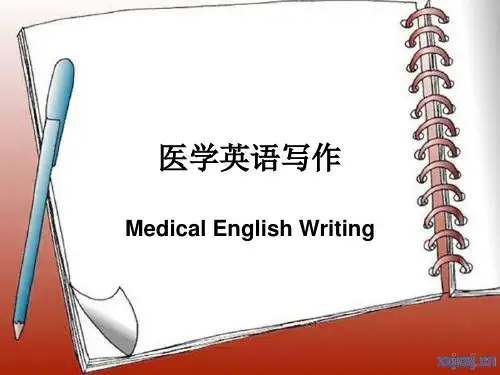
有关医学英语论文近年来,随着医学界的对外交流越来越多,人们越来越注意医学成果英语表达质量问题。
下面是店铺为大家整理的有关医学英语论文,供大家参考。
有关医学英语论文范文一:医学英语中时态和语态的翻译技巧论文导读:医学英语属于科技英语,而科技英语的翻译首先必须要达到“信”这个基本标准,即概念准确,句式严整。
综上所述,医学英语作为一门非常有特色的学科,除了学习一定的专业词汇,相关的医学知识之外,必要的翻译技巧和理论也是必须要掌握的,这会给你的翻译工作带来事半功倍的效果,也最终能翻译出脍炙人口,质量上乘的文章。
关键词:医学英语,时态,语态,翻译技巧医学英语属于科技英语,而科技英语的翻译首先必须要达到“信”这个基本标准,即概念准确,句式严整。
其次,译文必须简洁明了,自然流畅,即“达”。
除此之外,译者的中文文字功底一定要深厚,能够准确熟练的进行两种语言的转换,力争达到“雅”的高度。
在医学英语翻译过程中,时态是大多数译者碰到的一大难题,英语中的时态有很多种,并且都附着有词形的变化。
但是汉语就没有这些形态的变化。
所以很多人在翻译的过程中,他们不知何时该用何种时态。
有时全文从头到尾只用一种时态,或几种时态杂乱交错,给人不知所云的感觉。
我们要知道汉语强调的是意义,不太强调句子结构,许多句子没有主语,还有的句子主语不明显,但意义是明确的;而英语句子非常强调句子结构,绝大多数句子需要主语和谓语。
这就要求在英汉互译的过程中注重句意的转换,学会抓找中心词和使用各个关联词。
以下就医学英语中时态翻译的特点大致归类为:1.动词过去时态的译法与现在时态相同,一般不要加“了”、或“过”等字。
例如:Preliminaryhormone studies did not reveal any striking changes in this tissue.译为:初步的激素研究未显示这一组织有任何显著改变。
Shake down the mercuryafter you have read and recorded the temperature.译为:你看完温度并记录后,将水银甩下来。
本科毕业论文题目:医学英语的特点及翻译技巧院系:外国语言学系专业:英语(医学科技)学号:06260210学生姓名:李海静导师姓名:雍文明2005年5月On the Characteristics of Medical English Vocabulary and Translation SkillsA ThesisPresented to Xinxiang Medical UniversityByLi HaijingIn Impartial Fulfillment of the RequirementsFor the Degree ofBachelor of Arts in EnglishMay 2010Thesis Supervisor: Yong Wenming摘要在国际学术交流日益广泛当前,医学英语学习与医学文献翻译愈显重要。
要想了解和学习国外的先进医学技术,了解医学界的最新动态,掌握最新的医学成果以开阔视野、提高学习和科研能力,就必须广泛阅读和大量翻译这些科技文献。
本文通过对医学英语词汇的特点、翻译中的些许技巧作以分析,从而探讨提高医学英语学习与医学文献翻译效率的途径。
医学英语作为一种科技文体,其遣词造句、语法结构等有着自身的特点和规律,语言为的表达也具有较强的专业性,因而医学英语的翻译难度较大普通英语大得多,译者不仅需要拥有扎实的英语基础知识,还要具备相关的医学背景知识,才能是翻译更好达到“信、达、雅”的标准。
对医学翻译者来说,医学专业词会是其中阻碍之一。
随着医学科技的不断发展,新名词、新术语层出不穷,据统计,关于医学的新词,平均每年出现1500个之多。
因此掌握一些外国人医学词汇的方法尤为重要。
在医学英语术语中,用几个词组合起来构成一个新词是屡见不鲜,因此,翻译专业词汇,必须首先了解原词的含义,然后再根据所在的语境选择或创造汉语的专业词汇。
本文探讨了医学英语词汇的构词、来源、用词的选择等方面的特点,和如何利用这些特点对医学英语进行有效翻译。
医学英语作文Title: The Significance of Medical English in Global Healthcare。
Medical English plays a pivotal role in the global healthcare landscape, acting as a lingua franca that facilitates communication among healthcare professionals worldwide. In this essay, we will explore the importance of mastering medical English in both clinical and academic contexts, and its impact on patient care, research, and professional development.Firstly, proficiency in medical English is essentialfor effective communication among healthcare professionals from diverse linguistic backgrounds. In today's interconnected world, doctors, nurses, researchers, and other healthcare workers often collaborate on an international scale. Whether it's discussing patient cases, presenting research findings at conferences, or participating in medical training programs, a commonlanguage is crucial for conveying complex medical concepts accurately and comprehensively. Medical English serves as this common language, enabling healthcare professionals to exchange ideas, share knowledge, and collaborate seamlessly across borders.Furthermore, medical English proficiency is indispensable for providing high-quality patient care, especially in multicultural healthcare settings. Clear and accurate communication between healthcare providers and patients is paramount for ensuring informed consent, accurate diagnosis, and effective treatment. Patients who speak different languages or come from diverse cultural backgrounds may struggle to understand medical terminology and instructions if they are not communicated in a language they understand. By communicating medical information in English, healthcare professionals can bridge linguistic and cultural barriers, enhance patient understanding, and improve health outcomes.In addition to its role in clinical practice, medical English proficiency is also vital for academic and researchendeavors in the healthcare field. Medical research is a global endeavor, with researchers collaborating across continents to advance scientific knowledge and develop new treatments and therapies. Academic journals, conferences, and research institutions predominantly use English as the primary language for publishing and disseminating research findings. Thus, proficiency in medical English is essential for researchers to access and contribute to the latest advancements in their respective fields, participate in international collaborations, and communicate theirfindings to a global audience.Moreover, mastering medical English opens up opportunities for professional development and career advancement in the healthcare sector. Many prestigious medical institutions, universities, and healthcare organizations require proficiency in English as a prerequisite for admission, employment, or participation in training programs. Healthcare professionals who are proficient in medical English have a competitive edge in the job market, as they can pursue career opportunities both domestically and internationally. Additionally,proficiency in English may be necessary for obtaining certifications, licenses, or credentials required topractice medicine in certain countries or to specialize in specific medical fields.In conclusion, medical English plays a vital role inthe global healthcare landscape, facilitating communication, enhancing patient care, driving medical research, and enabling professional development. Healthcare professionals who master medical English not only improve their owncareer prospects but also contribute to the advancement of healthcare on a global scale. As the healthcare industry continues to evolve and become increasingly interconnected, the importance of medical English proficiency will only continue to grow. Therefore, investing in the acquisitionof medical English skills is essential for healthcare professionals seeking to excel in their careers and make meaningful contributions to the field of medicine.。
医学英语文章医学英语文章1精神身体医学好好反省一下吧Science and technology科学技术Psychosomatic medicine精神身体医学Think yourself well好好反省一下吧You can. But it helps to think well of yourself in the first place你可以的。
只是它会首先帮你好好反省一下自己。
THE link between mind and body is terrain into which many medical researchers, fearingridicule, dare not tread.大脑与身体之间存在着千丝万缕的联系,但是,因为怕被嘲笑,很多医学研?ahref='//' target='_blank'>咳嗽辈桓疑孀阏饪榱煊颉?/p>But perhaps more should do so.但是,可能应该有更多人来研究它。
For centuries, doctors have recognised the placebo effect, in which the illusion oftreatment, such as pills without an active ingredient, produces real medical benefits.数个世纪以来,医生们已经认识到了安慰剂的效力,其实是一种错觉治疗达到了真正的药物效应,比如没有实际疗效的药丸等。
More recently, respectable research has demonstrated that those who frequently experiencepositive emotions live longer and healthier lives.最近以来,相当受重视的研究表明,那些经常以积极的态度生活的人活得更长久,而且更健康。